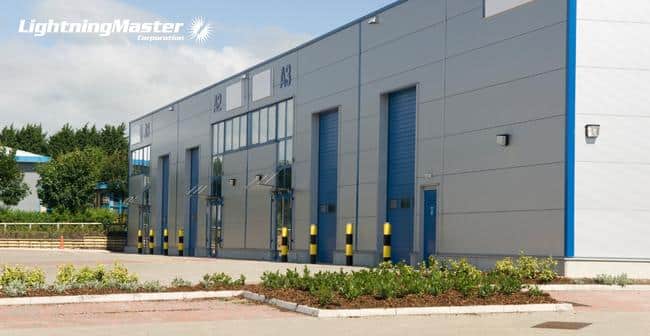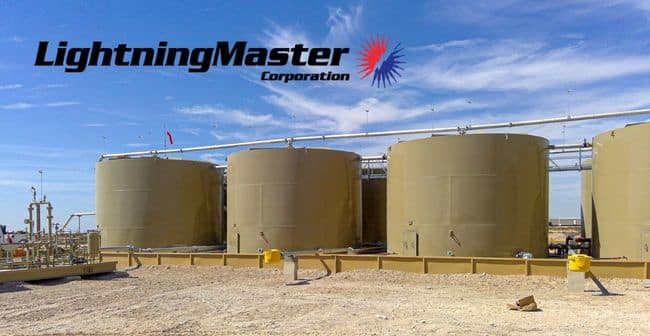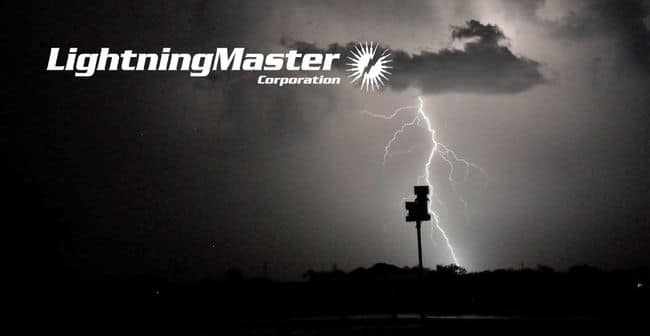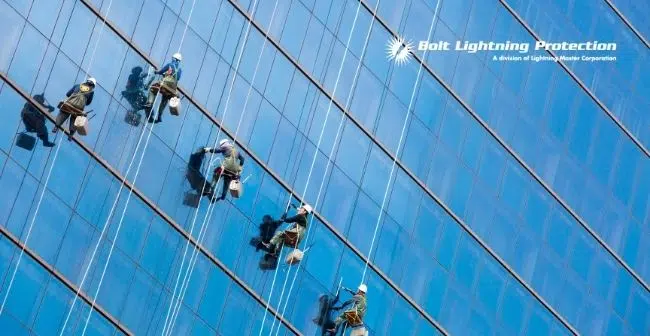What is Transient Voltage Surge Suppression?
Along with proper lightning protection equipment and techniques, surge suppression is another important factor when protecting your employees, property, and assets from lightning and surge damage. Energy surges can cause extended periods of downtime, which can be detrimental to your business and bottom-line.
There are many factors to consider when choosing the best surge suppression and protection equipment and services.
As explained by Lightning Master CEO, Bruce Kaiser,
“The energy and raw power contained in a lightning strike are truly awesome. It is easy to imagine the havoc which a direct strike to your facility can cause. However, the majority of electronics damage is not caused by direct lightning strikes, but is rather the result of transient voltage and current surges induced on power, telecommunications or RF transmission lines by the strong electromagnetic fields created during a lightning strike, and by more mundane causes such as power company switching, nearby heavy loads, traffic accidents involving utility poles, etc.
These surges can propagate for miles on metallic conductors, ending up at your facility service entrances retaining sufficient energy to damage or destroy electronic equipment. If you do not take steps to stop them, power surges can enter your facility and damage or upset your equipment. These transients were not so much of a problem in the days of vacuum tubes which operated on high internal voltages. However, with the introduction of microprocessors which operate on very low internal voltages, they have become a very real problem.
Every day, transients of all types are causing wear and tear on your equipment. With the move towards faster digital equipment, the problem will become more noticeable and expensive. The faster the electronic device, the more susceptible it is to transients. It is not possible to make electricity travel faster. Therefore, if you want to make device operate faster, the distance which the electricity travels must be reduced. When you reduce the distance, the arc-over voltage becomes lower. Therefore, the device is more susceptible to a transient. So there is a need for some type of device to stop power surges before they enter your facility, and to stop internally generated transients before they are distributed to your equipment.
A transient voltage surge suppression (TVSS) device simply limits the voltage to a value slightly above the nominal operating value of the system to allow normal operations, yet below a value which will allow damage to connected equipment. Lightning Master offers a full line of transient voltage surge suppression (TVSS) equipment for all types of services designed to provide the most efficient and cost-effective protection possible.
All-Mode Protection
Here are two types of transients: common mode and transverse mode.
To illustrate, let us examine the simplest type of system, a two wire 120 volt circuit. One wire, the line wire, is nominally at 120 volts compared to the electronic device. The other wire, the neutral or return wire, is nominally at zero volts compared to the equipment. As long as the difference in voltage is 120 volts, the electronic device is happy.
However, there are two types of transients which may appear on these wires. The first type is a transient on one wire. Say the line wire suddenly momentarily jumps from 120 volts to 2,120 volts with a 2,000 volt transient. The electronic device is straddling two wires looking for 120 volts. If it suddenly sees 2,120 volts, it may sustain damage.
The second type is a transient on both wires. With the same 2,00 volt transient, the potential, or voltage, on the line wire jumps to 2,120 volts, and the potential of the neutral wire jumps to 2,000 volts relative to the electronic device. In this case, the excess voltage may cause arcing between the electronic device and the chassis in which it is contained, which nominally remained at zero volts.
Therefore, in a two wire system, two modes, or legs, of surge suppression are required; one mode between the line and neutral wires and a second mode between the neutral wire and the equipment chassis or ground. The same principle applies to multiple wire systems; the more wires, the more modes of surge suppression required.
AC POWER
High voltage, high amperage transients may enter your facility on the AC power service. Therefore, it is important to employ a robust TVSS device at your AC power service entrance. Lightning Master offers the highest quality main panel devices to prevent transients from entering your facility from the outside. However, power company studies have revealed that the majority of the transients seen by your equipment do not come from outside your facility, but rather are generated inside your facility by motors and other loads.
Lightning Master also offers a full line of sub-panel TVSS devices to limit the “sharing” of internally generated transients. These devices are installed on your sub-panels, so that when a transient originating on one circuit travels back to its sub distribution panel, the TVSS device limits it before it can be redistributed onto other circuits within the panel, including circuits feeding your sensitive equipment. This approach of installing multiple TVSS devices in series is called “staged protection”, and is particularly effective in limiting damage from both externally and internally generated transients.
Telephone and Data
Telephone and data line transients may be high voltage, but are usually relatively low amperage, the current being ultimately limited by the wire size. However, telephone and data devices tend to be very susceptible to damage or interruptions caused by transients.
Therefore, high speed, tight clamping value TVSS devices should be employed at your telephone and data service entrances. Lightning Master offers a full line of TELCO and DATA TVSS devices for all applications, including POTS lines, T-1, and computer networks.
RF Transmission Line
Since RF transmission lines are connected to antennas which are often the highest structure in the area, they are capable of delivering high voltage, high amperage transients to your facility. Since DC power may be fed up a transmission line to power equipment near the antenna, TVSS devices for this application may have to be designed to allow DC power to pass unobstructed. Conventional devices employing internal RF coupling and gas tubes wired at a right angle to the main path through to the equipment are no longer capable of protecting modern equipment.
State-of-the art devices, devices in which the low impedance path leads to ground, and the higher impedance path leads to the equipment, need to be employed to secure maximum protection. Therefore, Lightning Master offers a full line of gas tube and one-quarter wavelength shunts.
Installation considerations: When planning a system layout, it is important to install surge suppressors to achieve maximum performance while avoiding situations which could compromise their performance.
During installation, avoid routing unprotected and ground wires adjacent and parallel to protected wires, where transients can be inductively coupled from the unprotected and ground wires onto the protected wires downstream of the surge suppressor. This also applies to routing protected wires from one type of service, particularly a low-voltage service such as telephone or data, adjacent to the unprotected or ground conductors of another service, such as AC power or radio frequency (RF) coaxial cables. A transient on either the unprotected or ground conductors of one service may be inductively coupled onto the protected conductors of the other service. Often we will see surge suppression elements installed directly on the circuit board they are intended to protect. This is less than optimum placement, as once the transient is on the board, it is generally too late to limit its propagation across the board.
Avoid locating a surge suppressor inside a metal enclosure containing the protected equipment. When a surge suppression element reacts to a transient, it emits an electromagnetic pulse (EMP). If the surge suppressor is located within the same metallic enclosure as the protected, the Faraday cage effect of the enclosure will tend to contain the emitted EMP within the enclosure where it may be inductively coupled onto conductors within the protected equipment. Therefore, the surge suppressor should be located outside the enclosure containing the protected equipment, using the Faraday cage effect to keep the EMP out of the enclosure.
Long conductors and bends in the conductors between a parallel TVSS device, such as an AC power surge suppressor, and the load it protects can dramatically affect surge suppressor performance. At a 3 kA, 8 x 20 microsecond pulse (IEEE standard pulse), each foot of conductor length can produce in an increase in clamping voltage of 150 to 200 volts. Therefore, in the case of a surge suppressor connected to a load with three feet of conductor, the inductive reactance of the conductor can increase the clamping voltage of the surge suppressor by 900 to 1200 volts (three feet in each direction between the surge suppressor and the load). Also, the travel time along the longer conductors can delay surge suppressor response time.
To address these and other problems, Lightning Master developed the services vestibule concept. As the name implies, a services vestibule is a separate enclosure through which all service conductors (AC power, telephone, data, RF, etc.) enter a site or remote equipment cabinet. Each service is grounded to a main ground bus within this vestibule. The main ground bus is grounded to an appropriate site ground and bonded to any structural lightning protection system. A surge suppressor installed on each service conductor and grounded to the main bus. No conductor enters the site or equipment cabinet until it has been grounded and surge suppressed in this separate, adjacent vestibule. This approach keeps all the “bad” things, such as grounding, surge suppression, and EMP, outside of the site or remote equipment cabinet. Only grounded, protected conductors are allowed inside.
Lightning Master will be pleased to assist you with your system layout to eliminate problems and to optimize surge suppressor performance.“
Contact Lightning Master For More Information About Surge Suppression
If you are ready to begin protecting your commercial facility with surge suppression equipment, contact Lightning Master Corporation today at 1-800-749-6800. We can also help with lightning protection for oil and gas facilities and lightning protection for fuel storage tanks. Call today to schedule a site survey, where our technicians will analyze and identify where to best implement surge suppression equipment to your commercial property and facility.




